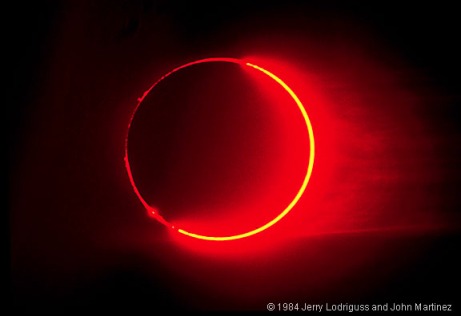 A solar eclipse occurs when the moon passes between the Sun and the Earth so that the Sun is fully or partially covered. This can only happen during a new moon, when the Sun and Moon are in conjunction as seen from the Earth.
A solar eclipse occurs when the moon passes between the Sun and the Earth so that the Sun is fully or partially covered. This can only happen during a new moon, when the Sun and Moon are in conjunction as seen from the Earth.
A total solar eclipse is a spectacular natural phenomenon and many people travel to remote locations to observe one. The 1999 total eclipse in Europe helped to increase public awareness of the phenomenon, as illustrated by the 
In ancient times, and in some cultures today, solar eclipses have been attributed to supernatural causes. Total solar eclipses can be frightening for people who are unaware of their astronomical explanation, as the Sun seems to disappear in the middle of the day and the sky darkens in a matter of minutes.
There are four types of solar eclipses:
- A total eclipse occurs when the Sun is completely obscured by the Moon. The intensely bright disk of the Sun is replaced by the dark silhouette of the Moon, and the much fainter corona is visible. During any one eclipse, totality is visible only from at most a narrow track on the surface of the Earth.
- An annular eclipse occurs when the Sun and Moon are exactly in line, but the apparent size of the Moon is smaller than that of the Sun. Hence the Sun appears as a very bright ring, or annulus, surrounding the outline of the Moon.
- A hybrid eclipse (also called annular/total eclipse) transitions between a total and annular eclipse. At some points on the surface of the Earth it is visible as a total eclipse, whereas at others it is annular. Hybrid eclipses are comparatively rare
- A partial eclipse occurs when the Sun and Moon are not exactly in line and the Moon only partially obscures the Sun. This phenomenon can usually be seen from a large part of the Earth outside of the track of an annular or total eclipse. However, some eclipses can only be seen as a partial eclipse, because the umbra never intersects the Earth’s surface.
The Moon’s Two Shadows
An eclipse of the Sun (or solar eclipse) can only occur at New Moon when the Moon passes between Earth and Sun. If the Moon’s shadow happens to fall upon Earth’s surface at that time, we see some portion of the Sun’s disk covered or ‘eclipsed’ by the Moon. Since New Moon occurs every 29 1/2 days, you might think that we should have a solar eclipse about once a month. Unfortunately, this doesn’t happen because the Moon’s orbit around Earth is tilted 5 degrees to Earth’s orbit around the Sun. As a result, the Moon’s shadow usually misses Earth as it passes above or below our planet at New Moon. At least twice a year, the geometry lines up just right so that some part of the Moon’s shadow falls on Earth’s surface and an eclipse of the Sun is seen from that region.
The Moon’s shadow actually has two parts:
1. Penumbra
The Moon’s faint outer shadow.
Partial solar eclipses are visible from within the penumbral shadow.
2. Umbra
The Moon’s dark inner shadow.
Total solar eclipses are visible from within the umbral shadow.
When the Moon’s penumbral shadow strikes Earth, we see a partial eclipse of the Sun from that region. Partial eclipses are dangerous to look at because the un-eclipsed part of the Sun is still very bright. You must use special filters or a home-made pinhole projector to safely watch a partial eclipse of the Sun
LINKS:



Pingback: Posts about solar eclipse july 2009 as of July 21, 2009 | MelaniedeJonge.com
Love the new look, keep up the great work the number of visitors must have increased?.
LikeLike
Pingback: चन्द्र ग्रहण | Rashid's Blog